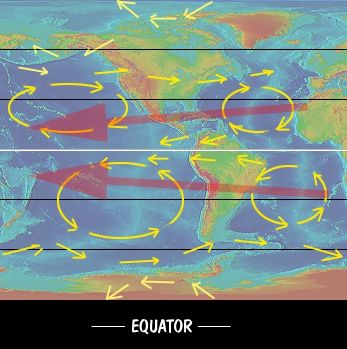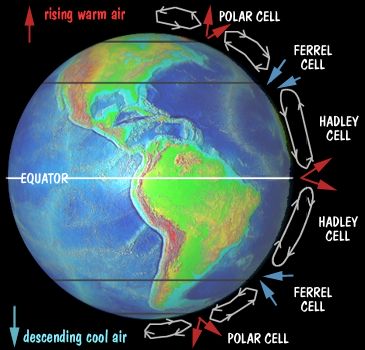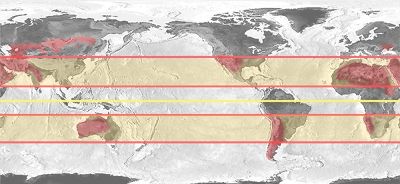The atmosphere is always in motion because of solar energy. The sun heats the equator more than the polar regions and there is always warm air rising from the equator. It moves either north or south and then cools at it moves nearer the poles. As it cools it once again becomes heavier and then sinks earthward. Since the air volume continues to grow at the pole, the heavy air begins travelling back to the equator pulled there by the vacating warm air.
The process continues over and over creating convection currents that keep the atmosphere in constant motion.


Air currents near the equator tend to move from east to west. This was vastly important during the early days of European exploration as wind power was the means of transport. By knowing the wind patterns ocean ships could select the correct regions to move either westerly or easterly.
The equator gets the highest concentration of continual sunlight and hence the warmest air. The air rises from the equatorial belt and moves both northward and southward. It is moist air from ocean evaporation. As it moves further from the equator the air temperature cools and water is continually lost as rain. This is the first (Hadley cell) on each side of the equator. By the time it reaches the northern end, it is now descending cool air. This is the beginning of the Ferrel cell.
This region of the globe gets little water and hence the majority of the worlds largest arid regions lie at or about this end of the Ferrel cell.

At the north end of the Ferrel cell, water in the air is once again more abundant due to rain in the northern higher altitude regions. It is also warmed by the land masses in the north and begins to rise again. It meets cold dry air coming down from the poles and once again can produce a band of rain as it rises.
It is the diversity of the earth's surface that creates the variety of weather we see. The oceans moving vast amounts of heat, the continents being warmed, and the having high mountains, all aid in producing a diverse system of local climates.
| NEXT | TOC | PREV |